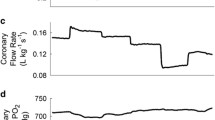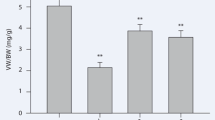Abstract
Left ventricular hypertrophy with adequate wall thickness, preserved adult phenotype and extracellular matrix may be useful in the prevention of heart failure. Because activation of subtype 1 of angiotensin II (AT1) receptors is thought to be involved in the hypertrophic response of cardiomyocytes, we tested the potential of systemic AT1 blockade to modify the development of left ventricular hypertrophy due to pressure overload.
Sham-operated rats and rats with ascending aorta constriction were treated with losartan (30 mg/kg/day) for 8 weeks. Left ventricular geometry, dynamics of isovolumic contractions, hydroxyproline concentration as well as myosin isozymes (marker of fetal phenotype) were assessed. Rats with aortic constriction exhibited a marked increase in left ventricular weight and the diastolic pressure-volume relationship was shifted to smaller volumes. An enlarged ventricular pressure-volume area and increased (p < 0.05) peak values of+dP/dtmax and-dP/dtmax demonstrated an enhanced overall ventricular performance. Signs of congestive heart failure were not apparent. In contrast, parameters of myocardial function (normalized length-stress area, +dσ/dtmax and -dσ/dtmax) were depressed (p < 0.05), indicating an impaired myocardial contractility. The hydroxyproline concentration remained unaltered. However, the proportion of ²-myosin heavy chains (MHC) was increased (p < 0.05). Administration of losartan decreased (p < 0.05) blood pressure and body weight in sham operated and pressure overloaded rats. By contrast, neither the concentric left ventricular hypertrophy or depressed myocardial function nor the increased ²-MHC expression were significantly altered. Thus, activation of AT1 receptors appears not to be involved in the initial expression of the fetal phenotype of pressure overloaded heart which may be responsible for the progressive functional deterioration of the hypertrophied ventricle. (Mol Cell Biochem 188: 225–233, 1998)
Access this chapter
Tax calculation will be finalised at checkout
Purchases are for personal use only
Preview
Unable to display preview. Download preview PDF.
Similar content being viewed by others
References
Schwartz K, Bouveret P, Bercovici J, Swynghedauw B: An immuno-chemical difference between myosins from normal and hypertrophied rat hearts. FEBS Lett 93: 137–139, 1978
Izumo S, Lompre AM, Matsuoka R, Koren G, Schwartz K: Myosin heavy chain messenger RNA and protein isoform transitions during cardiac hypertrophy: Interaction between hemodynamic and thyroid hormone-induced signals. J Clin Invest 79: 970–977, 1987
Chien KR, Knowlton KU, Zhu H, Chien S: Regulation of cardiac gene expression during myocardial growth and hypertrophy: Molecular studies of an adaptive physiologic response. FASEB J 5: 3037–3046, 1991
Schwartz K, Carrier L, Mercadier JJ, Lompre AM, Boheler KR: Molecular phenotype of the hypertrophied and failing myocardium. Circulation 87(Suppl. VII): VII–5–VII–10, 1993
Lompré AM, Anger M, Levitsky D: Sarco(endo)plasmic reticulum calcium pumps in the cardiovascular system: Function and gene expression. J Mol Cell Cardiol 26: 1109–1121, 1994
Feldman AM, Weinberg EO, Ray PE, Lorell BH: Selective changes in cardiac gene expression during compensated hypertrophy and the transition to cardiac decompensation in rats with chronic aortic banding. Circ Res 73: 184–192, 1993
Goldberg MR, Tanaka W, Barchowsky A, Bradstreet TE, McCrea J, Lo MW, McWilliams EJ, Bjomsson TD: Effects of losartan on blood pressure, plasma renin activity, and angiotensin II in volunteers. Hypertension 21: 704–713, 1993
Campbell DJ, Kladis A, Valentijn AJ: Effects of losartan on angiotensin and bradykinin peptides and angiotensin-converting enzyme. J Cardiovasc Pharm 26: 233–240, 1995
Levy BI, Benessian J, Henrion D, Caputo L, Heymes C, Diurez M, Poitevin P, Samuel JL: Chronic blockade of AT2-subtype receptors prevents the effect of angiotensin II on the rat vascular structure. J Clin Invest 98: 418–425, 1996
Weinberg EO, Lee NU, Weigner M, Lindpaintner K, Bishop SP, Benedict CR, Ho KKL, Douglas PS, Chafizadeh E, Lorell BH: Angiotensin AT1 receptor inhibition. Effects on hypertrophic remodelling and ACE expression in rats with pressure-overload hypertrophy due to ascending aortic stenosis. Circulation 95: 1592–1600, 1997
Schieffer B, Wirger A, Meybrunn M, Seitz S, Holtz J, Drexler H: Comparative effects of chronic angiotensin-converting enzyme inhibition and angiotensin II type 1 receptor blockade on cardiac remodelling after myocardial infarction in rats. Circulation 89: 2273–2282, 1994
Schunkert H, Jackson B, Tang SS, Schoen FJ, Smits JFM, Apstein CS, Lorell BH: Distribution and functional significance of cardiac ACE in hypertrophied rat hearts. Circulation 87: 1328–1339, 1993
Hirsch AT, Talsness CE, Schunkert H, Paul M, Dzau VJ: Tissue-specific activation of cardiac angiotensin converting enzyme in experimental heart failure. Circ Res 69: 475–482, 1991
Bruckschlegel G, Holmer SR, Jandeleit K, Grimm D, Muders F, Kromer EP, Riegger GAJ, Schunkert H: Blockade of the renin-angiotensin system in cardiac pressure-overload hypertrophy in rats. Hypertension 25: 250–259, 1995
Suzuki J, Matsubara H, Urakami M, Inada M. Rat angiotensin II (type A1) receptor mRNA regulation and subtype expression in myocardial growth and hypertrophy. Circ Res 73: 439–447, 1993
Kabour A, Henegar JR, Janicki JS: Angiotensin II (AII)-induced myocyte necrosis: Role of the AII receptor. J Cardiovasc Pharm 23: 547–553, 1994
Kromer EP, Riegger GAJ: Effects of long-term angiotensin converting enzyme inhibition on myocardial hypertrophy in experimental aortic stenosis in the rat. Am J Cardiol 62: 161–163, 1988
Kromer EP, Eisner D, Riegger GAJ: Role of neurohumoral systems for pressure induced left ventricular hypertrophy in experimental supra-valvular aortic stenosis in rats. Am J Hypertens 4: 521–524, 1991
Zierhut W, Zimmer HG, Gerdes AM: Effect of angiotensin converting enzyme inhibition on pressure-induced left ventricular hypertrophy in rats. Circ Res 69: 609–617, 1991
Golomb E, Abassi ZA, Cuda G, Stylianou M, Panchal VR, Trachevsky D, Keiser HR: Angiotensin II maintains, but does not mediate isoproterenol-induced cardiac hypertrophy in rats. Am J Physiol 267: H1496–H1506, 1994
Sabri A, Levy BI, Poitevin P, Caputo L, Faggin E, Marotte F, Rappaport L, Samuel JJ: Differential roles of AT1 and AT2 receptor subtypes in vascular trophic and phenotypic changes in response to stimulation with angiotensin II. Arterioscler Thromb Vasc Biol 17: 257–264, 1997
Grossman W: Cardiac hypertrophy: useful adaptation or pathologic process?. Am J Med 69: 576–584, 1980
Koide M, Nagatsu M, Zile M, Hamawaki M, Swindle NIM, Keech G, DeFreyte G, Tagawa H, Cooper IV G, Carabello BA: Premorbid determinants of left ventricular dysfunction in a novel model of gradually induced pressure overload in the adult canine. Circulation 95: 1601–1610, 1997
Penncock GD, Raya TE, Bahl JJ, Goldman S, Morkin E: Combination treatment with captopril and the thyroid hormone analogue 3,5-diiodo-thyropropionic acid (DITPA): A new approach to improving left ventricular performance in heart failure. Circulation 88: 1289–1298, 1993
Turcani M, Rupp H: Etomoxir improves left ventricular performance of pressure-overloaded rat heart. Circulation 96: 3691-3686, 1997
Weber KT, Brilla CG: Pathological hypertrophy and cardiac interstitium. Fibrosis and renin-angiotensin-aldosteron system. Circulation 83: 1849–1865, 1991
Brilla CG, Rupp H, Funck R, Maisch B: The renin-angiotensin-aldosterone system and myocardial collagen matrix remodeling in congestive heart failure. Eur Heart J 16(Suppl. O): 107–109, 1995
Litwin SE, Katz SE, Weinberg EO, Lorell BH, Aurigemma GP, Douglas PS: Serial echocardiographic-Doppler assessment of left ventricular geometry and function in rats with pressure-overload hypertrophy. Chronic angiotensin-converting enzyme inhibition attenuates the transition to heart failure. Circulation 91: 2642–2654, 1995
Jacob R, Brändie M, Dierberger B, Ross Ch: Conceptional and methodological basis for the evaluation of ventricular and myocardial mechanics. In: R. Jacob (ed.). Evaluation of Cardiac Contractility. Gustav Fischer, Stuttgart/New York, NY, 1987, pp 75–100
Hepp A, Hansis M, Gulch R, Jacob R: Left ventricular isovolu-metric pressure-volume relations, ‘diastolic tone’, and contractility in the heart after physical training. Basic Res Cardiol 69: 517–531, 1974
Jacob R, Dieberger B, Gülch RW, Noma K: Adaptive alterations in cardiac mass and configuration: beneficial or detrimental? A quantitative analysis based on the finite-element method. In: M. Nagano, N. Takeda, and N.S. Dhalla (eds). The Adapted Heart. Raven Press, New York, NY, 1994, pp 111–123
Sandier H, Dodge HT: Left ventricular tension and stress in man. Circ Res 13: 91–104, 1963
Rupp H, Wahl R, Hansen M: Influence of diet and carnitine palmitoyl-transferase I inhibition on myosin and sarcoplasmic reticulum. J Appl Physiol 72: 352–360, 1992
Stegemann, H: Mikrobestimmung von Hydroxyprolin mit Chloramin T und p-Dimethylaminobenzaldehyd. Hoppe-Seylers Z Physiol Chem 311: 41–45, 1958
Weinberg EO, Schoen FJ, George D, Kagaya Y, Douglas PS, Litwin SE, Schunkert H, Benedict CR, Lorell BH: Angiotensin-converting enzyme inhibition prolongs survival and modifies the transition to heart failure in rats with pressure overload hypertrophy due to ascending aortic stenosis. Circulation 90: 1410–1422, 1994
Rockman HA, Wachhorst SP, Mao L, Ross J Jr: ANG II receptor blockade prevents ventricular hypertrophy and ANF gene expression with pressure overload in mice. Am J Physiol 266: H2468–H2475, 1994
Everett AD, Tufro-McReddie A, Fisher A, Gomez RA: Angiotensin receptor regulates cardiac hypertrophy and transforming growth factor-²1 expression. Hypertension 23: 587–592, 1994
Ishiye M, Umemura K, Uematsu T, Nakashima M: Angiotensin AT1 receptor-mediated attenuation of cardiac hypertrophy due to volume overload: involvement of endothelin. Eur J Pharmacol. 280: 11–17, 1995
Sadoshima J, Izumo S: Molecular characterization of angiotensin II-induced hypertrophy of cardiac myocytes an hyperplasia of cardiac fibroblasts: Critical role of the AT, receptor subtype. Circ Res 73: 413–423, 1993
Ito H, Hirata Y, Adachi S, Tanaka M, Tsujino M, Koike A, Nogami A, Marumo F, Hiroe M: Endothelin-1 is an autocrine/paracrine factor in the mechanism of angiotensin II-induced hypertrophy in cultured rat cardiomyocytes. J Clin Invest 92: 398–403, 1993
Ruzicka M, Leenen FHH: Renin-angiotensin system and volume overload-induced cardiac remodeling. In: N.S. Dhalla, R.E. Beamish, N. Takeda and M. Nagano (eds). The Failing Heart. Lippincott-Raven Publishers, Philadelphia, 1995, pp 305–325
Lee KR, MacFadyen RJ, Doing JK, Reid JL: Role of angiotensin in the extravascular system. J Hum Hypertens 7(Suppl. 2): S7–S12, 1993
Sucic D, Nunez E, Frohlich Ed, Prakash O: Angiotensin II increases left ventricular mass without affecting myosin isoform mRNAs. Hypertension 28: 265–268, 1996
Rupp H, Wahl R, Hansen M: Influence of diet and carnitine palmitoyl-transferase I inhibition on myosin and sarcoplasmic reticulum. J Appl Physiol 72: 352–360, 1992
Vetter R, Rupp H: CPT-1 inhibition by etomoxir has a chamber-related action on cardiac sarcoplasmic reticulurn and isomyosins. Am J Physiol 267: H2091–H2099, 1994
Zarain-Herzberg A, Rupp H, Elimban V, Dhalia NS: Modification of sarcoplasmic reticulum gene expression in pressure overloaded cardiac hypertrophy by etomoxir. FASEB J 10: 1303–1309, 1996
Crawford DC, Chobanian AV, Brecher P: Angiotensin II induces fibonectin expression associated with cardiac fibrosis in the rat. Circ Res 74: 727–739, 1994
Pickering JG, Bougimer DR: Fibrosis in the transplanted heart and its relation to donor ischemic time. Assessment with polarized light microscopy and digital image analysis. Circulation 81: 949–958, 1990
Author information
Authors and Affiliations
Editor information
Editors and Affiliations
Rights and permissions
Copyright information
© 1998 Springer Science+Business Media Dordrecht
About this chapter
Cite this chapter
Turcani, M., Rupp, H. (1998). Development of pressure overload induced cardiac hypertrophy is unaffected by long-term treatment with losartan. In: Pierce, G.N., Izumi, T., Rupp, H., Grynberg, A. (eds) Molecular and Cellular Effects of Nutrition on Disease Processes. Developments in Molecular and Cellular Biochemistry, vol 26. Springer, Boston, MA. https://doi.org/10.1007/978-1-4615-5763-0_24
Download citation
DOI: https://doi.org/10.1007/978-1-4615-5763-0_24
Publisher Name: Springer, Boston, MA
Print ISBN: 978-1-4613-7641-5
Online ISBN: 978-1-4615-5763-0
eBook Packages: Springer Book Archive




